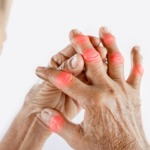 Arthritis is a common condition that affects millions of people worldwide. One of the most challenging aspects of living with arthritis is dealing with pain. In this article, we will explore what arthritis is and delve into understanding pain associated with the condition.
Arthritis is a common condition that affects millions of people worldwide. One of the most challenging aspects of living with arthritis is dealing with pain. In this article, we will explore what arthritis is and delve into understanding pain associated with the condition.
Pain is a complex and subjective experience that varies from person to person. It is an important way for our bodies to signal that something is wrong.
In the case of arthritis, pain is often a result of inflammation, joint damage, or the body’s response to the condition. It can range from mild discomfort to severe, chronic pain that significantly affects daily activities.
Pain is defined as an unpleasant sensory and/or emotional experience associated with actual or potential tissue damage.
The sensation of pain is generated by nerves that send signals to our brains letting it know organs or tissues are damaged or irritated.
Pain can be divided into two categories:
#1. Acute Pain – this pain is temporary and goes away quickly. It is very useful because it lets your body know that something is damaged and to protect it so that you can heal.
#2. Chronic Pain – is unpleasant and can last a long time. If the pain stays in the same location for greater than 3-6 months, it is described as chronic pain. This type of pain is not useful because it may persist for long periods of time without evidence of further injury. It does not act as a warning system but may lead to depression, despair, helplessness, and loss of function.
Types of Pain in Arthritis:
#1. Joint Pain:
The most common type of pain in arthritis is joint pain. It is characterised by aching, stiffness, and soreness in the affected joints. Joint pain can vary in intensity and may be worse after periods of inactivity or repetitive use of the joints.
#2. Inflammatory Pain:
Inflammatory pain is associated with conditions like rheumatoid arthritis, where the immune system attacks the joints. It is often characterised by redness, swelling, and warmth in the affected areas, in addition to pain.
#3. Nerve Pain:
In some cases, arthritis can cause nerve pain. Nerve pain, also known as neuropathy, is characterised by shooting or burning sensations, tingling, or numbness in the affected areas.
#4. Muscular Pain:
Arthritis can also lead to muscular pain. Muscular pain is usually a result of the muscles working harder to compensate for weak or damaged joints. It can present as muscle aches, stiffness, or tension.
What causes arthritis pain?
- Inflammation, this process causes heat and swelling in joints
- Damage to the joint affected
- Muscle tension, from trying to protect joints from painful movements
For some conditions, such as Fibromyalgia, the cause of the pain is not fully understood.
The Pain Cycle
Pain can be exacerbated by several things in our daily life. Pain, stress, fatigue, and depression all affect one another.
For example, people who feel depressed or anxious have been found to be more sensitive to pain. This can make your pain feel worse, which leads to a continuing cycle of fatigue and depression.
Pain may limit some of the things you do, but it doesn’t have to control your life.
Understanding and Managing Pain
#1. Self-awareness:
It is important to pay attention to your body and understand your pain. Recognise the triggers and factors that worsen or alleviate your pain. This self-awareness can help you make informed decisions about managing your pain.
#2. Medications:
There are various medications available to help manage arthritis pain. Over-the-counter pain relievers like acetaminophen or nonsteroidal anti-inflammatory drugs (NSAIDs) can provide temporary relief. For severe or chronic pain, prescription medications may be necessary. Consult with your healthcare provider to determine the most suitable options for your specific situation.
#3. Physical Activity:
Engaging in regular, low-impact exercises can help reduce arthritis pain. Exercise strengthens the muscles around the joints, improves flexibility and range of motion, and promotes overall joint health. Consult with a healthcare professional or physical therapist to develop a safe and appropriate exercise routine.
#4. Hot and Cold Therapy:
Applying heat or cold to affected joints can help alleviate pain. Heat, such as warm towels or heating pads, can help relax muscles and ease stiffness. Cold packs or ice packs can reduce inflammation and numb the area, providing temporary pain relief.
#5. Lifestyle Modifications:
Making certain lifestyle changes can also help manage arthritis pain. Maintaining a healthy weight reduces the burden on the joints. Using assistive devices or adapting your environment to minimise joint strain can be beneficial. Practicing stress-reduction techniques, such as meditation or deep breathing exercises, can also contribute to pain management.
#6. Support and Education:
Seek support from healthcare professionals, support groups, or online communities to gain knowledge about arthritis and pain management strategies. Learning from others who share similar experiences can provide valuable insights and emotional support. Also speak with your GP about a – Persistent Pain Management Services – this requires a referral from a GP. For more information, download our free infosheet on Dealing with Pain.
Arthritis and pain often go hand in hand, but understanding pain and implementing appropriate strategies can help individuals effectively manage their symptoms.
By familiarising themselves with the different types of pain associated with arthritis, exploring various pain management techniques, and seeking support, individuals can lead fulfilling lives despite the challenges posed by arthritis.
Remember, you have the power to take control of your pain and improve your quality of life.
Don’t forget to register for our webinar on 12 July 2023 or watch the recording that take a deeper dive into Arthritis and Pain.
Online resources and courses that can help you learn more about chronic pain and ways to help manage or cope with it –
Chronic pain explained – NPS Medicinewise
MindSpot Pain Course
The Chronic Pain Course – This Way Up
Pain Australia’s Pain Directory – this resource is a guide to the various levels of available pain services in Australia.
Source:
- Understanding Pain. Northwestern medicine. N.d
- Arthritis Australia. Dealing with Pain information sheet. Dec 2017.
Breanna Jones
Health Promotions Coordinator
Arthritis Queensland
July 2023
